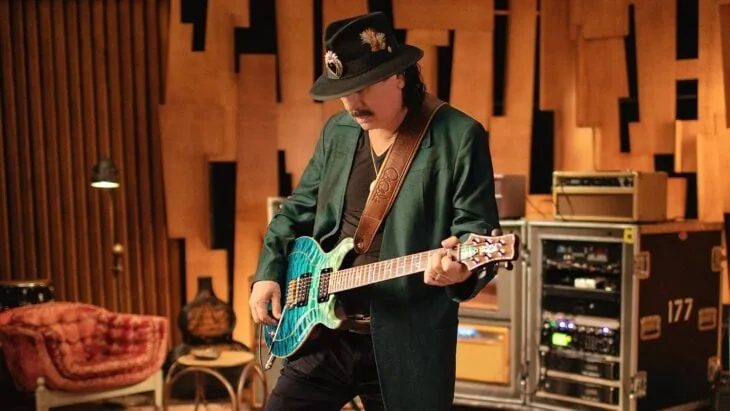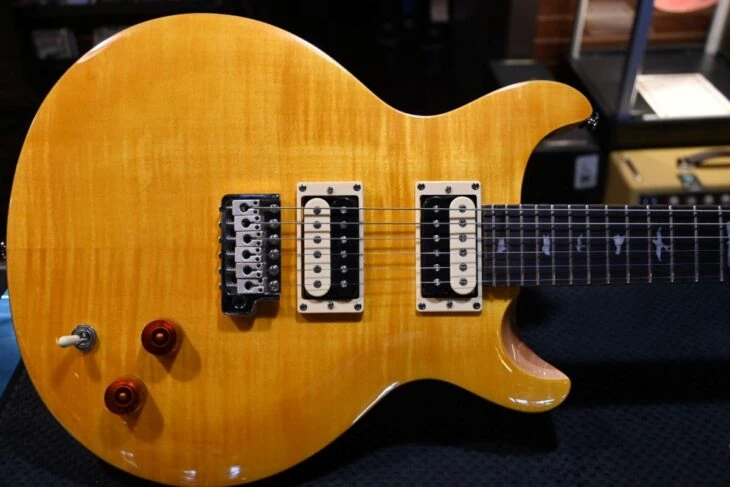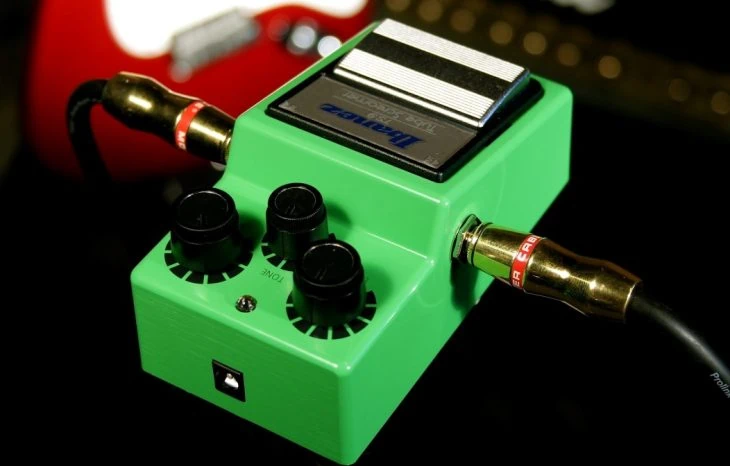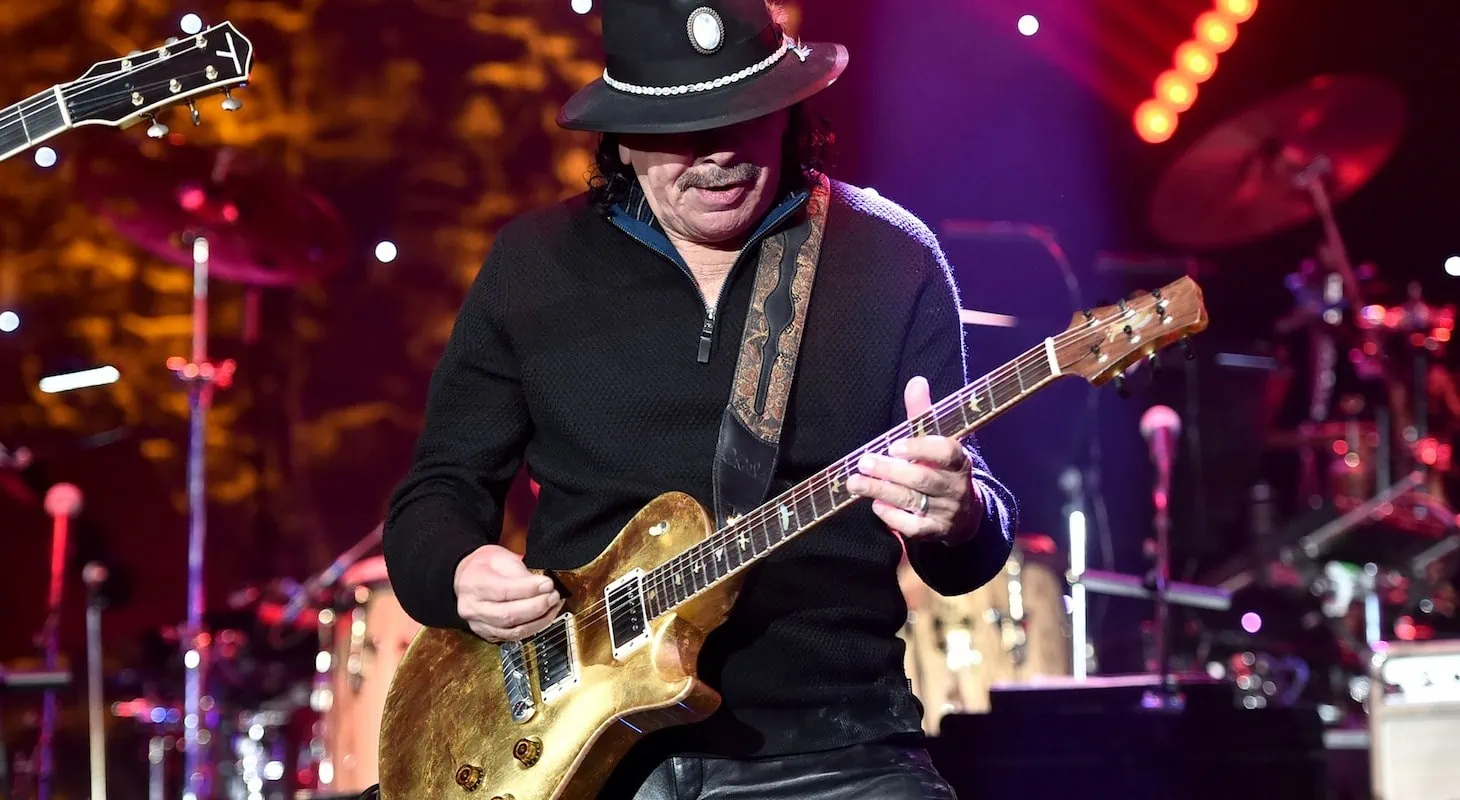Carlos Santana is one of the few guitarists who can make virtuosic guitar music that appeals to absolutely everyone. He rose to fame in the late ’60s and early ’70s thanks to his unique ability to weave Latin influence into his world-class guitar solos. This gave his style a special draw that resonated with both musicians and non-musicians alike.
Carlos puts a huge emphasis on tasteful phrasing, emotive melodies, and of course having a stellar lead guitar tone that many people would love to try out for themselves.
So in this article, I’m going to walk you through all the main guitars, amps, pedals, and settings Santana uses to achieve such soul-stirring guitar tones.
Table of Contents
Guitars
If you’re a fan of Santana, you will likely already know that he is most well-known for using PRS guitars. He has a long-running series of signature models with the company which can be boiled down to two primary instruments.
Firstly is the PRS Santana Retro signature model. This is the big boy and is part of PRS’ most premium line of guitars. It uses the best of the best in almost every capacity, from the best-figured maple top, PRS’ own 58/15 custom pickup combination, and their new Gen III tremolo system which is machined to provide unparalleled stability and control over the whammy bar.

Now if your eyes started to water after seeing the price tag, don’t worry!
PRS also offers a PRS SE Santana signature model which comes in at a fraction of the cost. The SE stands for student edition and it’s designed to still hit all the main beats of the more expensive version but is produced overseas, in larger quantities, and using cheaper components to keep the cost down.

But don’t let that deter you, most professional musicians will tell you that PRS SE guitars are more than capable of handling even the most demanding of musical applications and will easily be able to produce some great Santana tones.
Tuning
The overwhelming majority of Carlos’ music is in regular E standard (E A D G B E).
However, for a select few songs such as Europa, he uses a common altered tuning called DADGAD. Quite literally tuned to D A D G A D which creates an open Dsus4 chord.
Amps
With a career that extends over 50 years, Carlos has used a lot of different amps. However, if you wanted a single amplifier that could sum up the Santana sound it would have to be the Mesa Boogie Mark series.
Over the years he’s kept up with the iterations of these amplifiers as Mesa Boogie has released them, starting off using the Mark I and II and these days he is using the Mark IV model.
These are incredibly versatile amps that are wide and dynamic enough in their channels, knobs, and EQs to be able to achieve basically any sound you can envision. Owning a Mark amplifier is the equivalent of owning an entire suite of amplifiers because of how versatile they are.
The Mark IV is pretty hard to source now and is usually only available on the used market. But the Mesa Mark VII and Mark V:35 are both still readily available.

Unfortunately, there are no real all-tube equivalencies to these amplifiers for those on a budget, so if you’re looking for something cheaper, your best bet is to head into digital modeling territory with something like the TONEX pedal from IK Multimedia.
Carlos Santana Amp Settings
Carlos’ tone is the epitome of expression and dynamic response. The amplifier needs to be set in a way that fully responds to all the subtle movements you make with your hand. This means you should be measured with your settings and focus mainly on balance and clarity.
Gain: 6 – This might seem low for a driven lead guitar tone, but his playing is extremely clean and you should be looking to avoid extraneous string noise. You’re going to need to be articulate with your picking to achieve good sustain while using so little gain.
Bass: 5 – Carlos’ lead sound isn’t particularly bass-heavy, but it does need to have some meat on it and be able to fill up a good amount of the frequency spectrum.
Mids: 7 – A solid boost to the mids here really helps bring out the pick attack and allows the guitar to stand out in the mix.
Treble: 6 – His tone is generally warm and not particularly harsh on the top end. So a small boost here can help give it a bit of that glassy sheen while avoiding any harsh harmonics and fizziness that might come with pumping too much high-end into it.
Smooth
Smooth has a unique lead tone that is very dark and toned down. So raising the gain and reducing the mids a bit helps tame an otherwise loud and proud lead sound into something that takes on more of a supporting role in the song.
Gain: 7
Bass: 6
Mids: 5
Treble: 4
Corazon
The electric guitar parts on this song also take on more of a supporting role, it’s a very warm and rich sound without too much harsh top end with just a little bit of breakup and grit, but not to the point where you’d call it a distorted tone.
Gain: 3
Bass: 6
Mids: 5
Treble: 6
Black Magic Woman
Black Magic Woman has more single-note lead lines, and as such you should be looking to pump up the mids just a bit so the guitar can pull a bit more attention and cut through the mix.
Gain: 4
Bass: 4
Mids: 7
Treble: 6
Pedals
For the most part, Carlos relies on the raw tone of his Mesa amplifiers to carry the tone. But there are a few key pedals that come into play that help just boost or augment his tone slightly and give it a little extra oomph for certain sections of the song.
Most importantly, there is the Ibanez TS9 Tube Screamer which he runs in front of his Mesa Mark amplifier. While most players (particularly those involved in heavier genres of music) will leave their screamer on all the time to tighten the amp up, Carlos’ playing and tones are far more dynamic and varied, so this will only be turned on for specific sections for a bit of extra juice.

He also famously used the Big Muff fuzz pedal at Woodstock, although at the time it was just a prototype, due to the pedal’s staggering popularity it’s still widely available in stores today.
His wah pedal of choice is the Mu-Tron wah, but these are pretty difficult to get ahold of. So in lieu of that, you cannot go wrong with the good old Jim Dunlop GCB95 crybaby wah, and there’s also a TC Electronic delay which is controlled off-stage.
Timeless Appeal
Carlos is one of the few players whose guitar playing appeals to people of all ages. It’s classic yet somehow still every bit as appropriate today as it was back in the ‘70s.
He’s the perfect example of how good guitar playing never goes out of style and I hope you have some fun using the information shared today to recreate some of his most iconic sounds for yourself.

